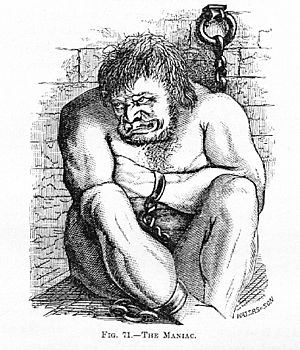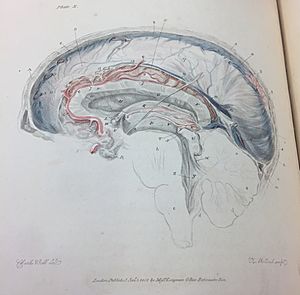Charles Bell facts for kids
Quick facts for kids
Sir Charles Bell
KH FRS FRSE FRCSE
|
|
|---|---|
 |
|
| Born | 12 November 1774 |
| Died | 28 April 1842 (aged 67) Hallow, Worcestershire, England
|
| Nationality | Scottish |
| Alma mater | University of Edinburgh |
| Known for | authority on the human nervous system |
| Awards | Royal Medal (1829) |
| Scientific career | |
| Fields | anatomy |
| Institutions | Surgeon, Edinburgh Royal Infirmary (1799–) Practising surgeon, London (1804–) Principal Lecturer, Great Windmill Street School of Anatomy (1812–25) Lectured at Middlesex Hospital etc (1812–36) Professor of Surgery, Edinburgh University (1836–42) |
| Notes | |
|
Author of "Treatise on Animal Mechanics", "An Essay on the Hand, its Mechanism and Vital Endowments as Evincing Design"
|
|
Sir Charles Bell KH FRS FRSE FRCSE MWS (12 November 1774 – 28 April 1842) was a famous Scottish doctor. He was a surgeon, an anatomist (someone who studies the body's structure), and a physiologist (someone who studies how the body works). He was also an artist and a thinker about philosophy.
Bell is most famous for figuring out the difference between two types of nerves in the spinal cord. These are sensory nerves, which send feelings (like touch or pain) to the brain, and motor nerves, which send signals from the brain to make muscles move. He also described a condition called Bell's palsy, which causes one side of the face to become weak or paralyzed.
Charles Bell had three older brothers who were also successful. One was a surgeon, and another became a law professor at the University of Edinburgh.
Contents
Early Life and Education
Charles Bell was born in Edinburgh, Scotland, on November 12, 1774. He was the fourth son of Reverend William Bell. When Charles was five, his father passed away. His mother played a big role in teaching him to read and write. She also supported his artistic talent by arranging drawing and painting lessons for him with a well-known Scottish painter, David Allan.
Charles grew up in Edinburgh and went to the High School from 1784 to 1788. Even though he wasn't the best student, he decided to follow his brother John into medicine. In 1792, Charles Bell started at the University of Edinburgh. He helped his brother John as a surgical apprentice. He also took classes on anatomy and drawing to improve his artistic skills.
In 1798, Bell finished his studies at the University of Edinburgh. He then joined the Royal College of Surgeons of Edinburgh. There, he taught anatomy and performed surgeries at the Royal Infirmary of Edinburgh. Charles was very good at combining his interest in anatomy with his artistic skills. He helped his brother finish a four-book series called The Anatomy of the Human Body. Charles wrote and drew all the pictures for the last two books in 1803. He also published his own drawings in a book called System of Dissections in 1798 and 1799.
Bell also enjoyed making wax models of interesting medical cases. He collected many of these models, calling it his Museum of Anatomy. Some of these models can still be seen today at Surgeon's Hall.
Charles Bell didn't stay in Edinburgh for long. His brother John had a disagreement with two professors at the University of Edinburgh. This led to the Bell brothers not being allowed to work at the Royal Infirmary. Charles tried to make a deal with the university, offering them money and his Museum of Anatomy. In return, he wanted to watch and draw surgeries at the Royal Infirmary, but his offer was turned down.
Moving to London and Military Service
In 1804, Charles Bell moved to London. By 1805, he had set up a house where he taught anatomy and surgery to medical students, doctors, and artists.
Bell also helped soldiers during wartime. In 1809, he volunteered to care for wounded soldiers who had retreated from Corunna. Six years later, he again helped wounded soldiers after the Battle of Waterloo in 1815. He operated on French soldiers for three days and nights. Sadly, many of his patients died because their injuries were very severe. Bell was especially interested in injuries caused by musket balls. In 1814, he published a book called Dissertation on Gunshot Wounds. Many of his drawings of these wounds are displayed at the Royal College of Surgeons of Edinburgh.
Teaching and Research
In 1811, Charles Bell married Marion Shaw. Using money from his wife's dowry, Bell bought a share of the Great Windmill Street School of Anatomy. This school was started by another anatomist named William Hunter. Bell moved his practice there and taught students and did his own research until 1824. In 1813 and 1814, he became a member of the London College of Surgeons and a surgeon at the Middlesex Hospital.
Bell was very important in starting the Middlesex Hospital Medical School. In 1824, he became the first professor of Anatomy and Surgery at the College of Surgeons in London. That same year, he sold his collection of over 3,000 wax models to the Royal College of Surgeons of Edinburgh for £3000.
In 1829, the Windmill Street School of Anatomy became part of the new King's College London. Bell was asked to be its first professor of physiology. He helped set up the Medical School at the University of London and gave the opening speech. However, Bell didn't stay long because he had different ideas from the other teachers. For the next seven years, he gave lectures at the Middlesex Hospital. In 1835, he accepted a job as the Chair of Surgery at the University of Edinburgh.
He was made a Knight of the Royal Guelphic Order in 1833, which meant he could use "Sir" before his name.
Charles Bell died in 1842 while traveling from Edinburgh to London. He is buried in Hallow Churchyard near Worcester.
Discoveries and Writings
Charles Bell wrote many books. He combined his knowledge of anatomy with his artistic skills to create detailed and beautifully illustrated works.
- In 1799, he published his first book, "A System of Dissections, explaining the Anatomy of the Human Body...".
- In 1803, he finished his brother's four-book series, "The Anatomy of the Human Body".
- That same year, he published three sets of detailed drawings called "Engravings of the Arteries", "Engravings of the Brain", and "Engravings of the Nerves". These drawings were meant to help medical students learn. The "Engravings of the Brain" were especially important because they showed Bell's early ideas about how the nervous system is organized.
In 1806, Bell published Essays on The Anatomy of Expression in Painting. This book explored how facial muscles show emotions. He believed that humans had special facial muscles given to them by a Creator.
Bell made very important discoveries about the nervous system. In 1811, he published a book called An Idea of a New Anatomy of the Brain. In this book, he described his idea that different parts of the brain and nerves have different jobs. He did experiments on a rabbit's spinal cord. He found that touching the front part of the spinal cord made muscles twitch, but touching the back part had no effect. This led him to believe he was the first to tell the difference between nerves that control movement (motor nerves) and nerves that sense feelings (sensory nerves). This idea was a huge step forward in understanding the brain and nerves.
In 1821, Bell published another important paper called "On the Nerves". In this paper, he described his most famous discovery: that the facial nerve (the seventh cranial nerve) controls facial muscle movement. Before this, surgeons sometimes cut this nerve to try and cure facial pain. But this often caused one side of the patient's face to become paralyzed. This condition is now known as Bell's palsy. Because of this work, Charles Bell is seen as one of the first doctors to combine scientific study of the nervous system with treating patients.
Bell also wrote a book called The Hand: Its Mechanism and Vital Endowments as Evincing Design in 1833. In this book, he compared the "hands" of different animals, like human hands, chimpanzee paws, and fish fins. He also wrote about how important the hand is in surgery and how doctors need to train their hands as much as their eyes.
Legacy and Lasting Impact
Many discoveries and medical terms are named after Charles Bell:
- Bell's (external respiratory) nerve: This is another name for the long thoracic nerve.
- Bell's palsy: This is a condition where one side of the face becomes weak or paralyzed because of a problem with the facial nerve.
- Bell's phenomenon: This is when your eye moves up and out when you try to close it very tightly. Doctors can see this in patients who can't close their eyes properly, like those with Bell's palsy.
- Bell's spasm: This refers to uncontrolled twitching of the facial muscles.
- Bell-Magendie law or Bell's Law: This law states that the front parts of spinal nerve roots only carry signals for movement, and the back parts only carry signals for feeling.
Today, a building at University College London called Charles Bell House is used for teaching and research in surgery.
Honours and Awards
- Bell was chosen as a Fellow of the Royal Society of Edinburgh in 1807.
- He became a Fellow of the Royal Society of London in 1826.
- He received the Royal Society's gold medal for his many scientific discoveries.
- He was knighted as a Knight of the Guelphic Order of Hanover in 1831.
Images for kids
See also
 In Spanish: Charles Bell para niños
In Spanish: Charles Bell para niños





